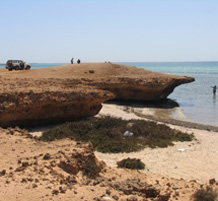The Southern Red Sea Project
Description
This project took place between 2007-2009, and was a joint Saudi-UK project, led by Geoff Bailey and Abdullah Alsahrekh (King Saud University), as a continuation of the Africa-Arabia Connections project.
Research Context
Considerable interest has focussed in recent years on the 'southern dispersal route' for Pleistocene human dispersal between Africa and Asia, i.e. across the southern end of the Red Sea and directly into the Arabian Peninsula and around the coastline of the Indian Ocean into southern Asia, especially for anatomically modern humans within the past 150,000 years.
However, despite numerous surface finds of stone tools in the Arabian Peninsula and much speculation there is a:
- Dearth of well-dated field data in the critical region of southern Arabia
- Uncertainty about the impact of sea level change on the Bab al Mandab crossing and its implications for sea crossings
- Unresolved questions about the time depth of human exploitation of marine resources
- Growing realisation that most of the relevant evidence is on now-submerged coastlines that require the development of underwater techniques of archaeological and palaeoenvironmental survey
This project built on the results of the Africa-Arabia Connections project and was designed to continue field explorations and field observations in the Farasan Islands and to develop the framework of understanding and collaborative arrangements to sustain long-term fieldwork in the region.
Funding
- British Academy
- National Geographic Society
Sponsors
- Deputy Ministry of Education, Saudi Arabia
- Commission for Tourism and Antiquities, Saudi Arabia

